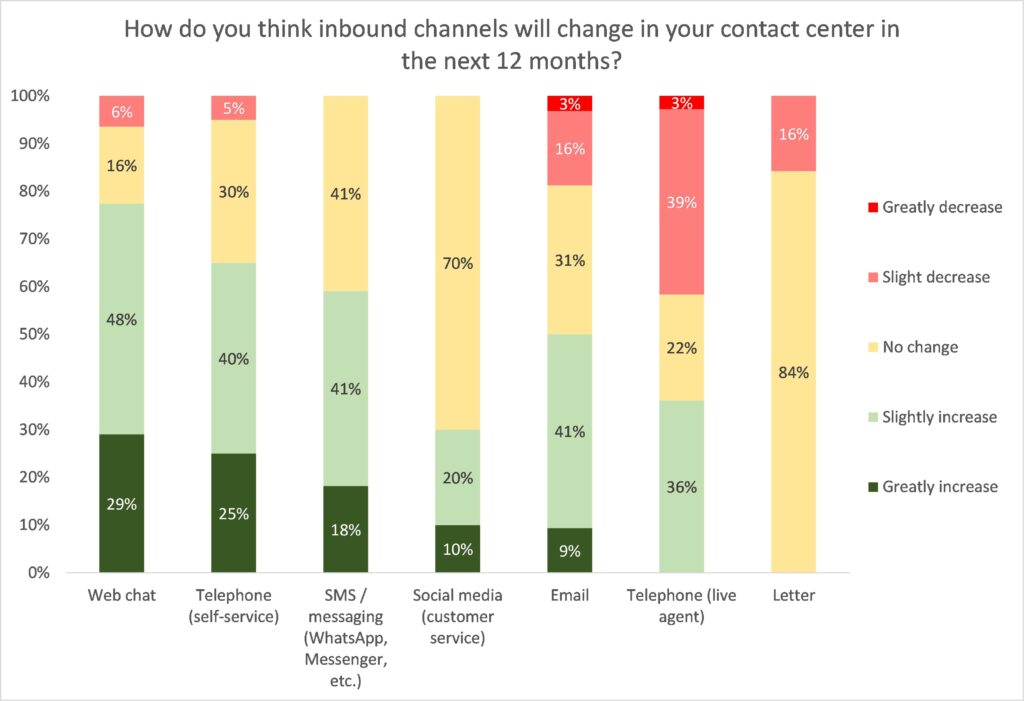What does the use of digital customer service channels tell us about what US contact centers’ priorities should be?
A key theme among the findings of surveys of United States contact centers has been the emergence of all manner of digital customer contact channels in recent years.
But in an age in which there is intensifying talk of the ever-greater use of automation and artificial intelligence (AI) across so many aspects of businesses’ operations, it is worth asking whether there has been an uptick in the use of such solutions lately, and what broader implications this could have for contact center strategy.
Web chat looks likely to be used more and more, as traditional letter communication declines
Recent US call center research involved organizations being questioned on how they thought a range of inbound channels would change in their contact center over the coming 12 months (presuming the respondent’s contact center uses the given channel).
How do you think inbound channels will change in your contact center in the next 12 months? (if used)

It was found through this line of questioning that 29% of respondents expected web chat to see greater use in their contact center during the next 12 months, and a further 48% anticipated a slight increase; only 6% of respondents anticipated the use of web chat actually going down at their contact center.
Ranked not too far behind web chat in usage expectations was self-service telephone contact, with 25% of those surveyed expecting it to go up greatly, and 40% expecting it to increase slightly. By contrast, when it came to live-agent telephone contact, 39% of respondents said they anticipated a slight decrease in its usage at their contact center, although a similar proportion (36%) thought usage of this channel would actually rise slightly over the coming year.
Meanwhile, the traditional media of letters is expected by 16% of respondents to be used less frequently at their contact center over the next 12 months, with the remaining 84% not thinking that their contact center will use letters either more or less often as a customer service channel, often because they receive almost no letters anyway.
A key message to take away from these findings is that channels are generally being augmented, rather than replaced. That, in turn, will mean businesses having to accept the need to develop an omnichannel approach, as this is what their customers are expecting.
Seemingly cheaper channels aren’t saving as much money as might have been expected
Traditionally, decisions by businesses to invest in a specific channel for contact with customers have often been driven by cost considerations. However, history shows that initially anticipated cost reductions through such moves haven’t always been delivered.
Back in the late 1990s, for instance, when email began to emerge as a customer service channel, it was thought that it would prove to be a low-cost alternative to voice. But in practice, it often turned out to be a merely low-quality alternative to voice. It also commonly took as much time and effort (and therefore, expense) to answer an email as it did to answer a phone call.
Looking at data gathered from much more recent US call center research, it is interesting to see that although there does appear to be some cost differential between telephony and digital channels, there is not as dramatic a gap as many observers might expect.
Cost per inbound interaction (phone, social media, email & web chat)

So, why are digital channels not proving themselves to be as much of a money-saver as might have been anticipated? Well, one factor is likely to be the fact that many businesses are still using a relatively low level of automation.
It should also be noted that if email is used and the query is not answered satisfactorily with just one response, the customer will need to send further emails, and perhaps reach out through other channels, such as telephone. Such additional emails and phone calls can quickly drive up the cost higher than would have been the case if the customer had simply called in the first place.
Even putting aside whether automation is or isn’t embraced by a given contact center, 31% of survey respondents state that more than half of the social media requests they receive require another channel before the query can be effectively resolved. Other digital channels also see this pattern, albeit somewhat less strongly.
And with customers preferring not to have to re-explain issues or re-enter information when they move between channels, it is clear that organizations simply must embrace an omnichannel strategy for achieving the most seamless experience that drives up customer satisfaction.
The omnichannel genie is, in effect, “out of the bottle”, and cannot be put back by an organization even if it might wish to backtrack – or at least, not without serious damage being caused to the customer experience.
Would your own organization appreciate further insights like the above to help guide its strategic decision-making? If so, our “2023 US Contact Center Decision-Makers’ Guide” is available to download right now, with important lessons for those that wish to optimize their own contact center operations for the 2020s.

